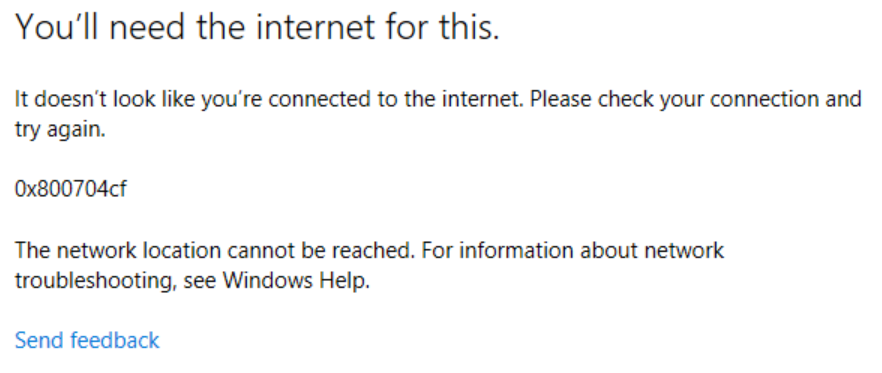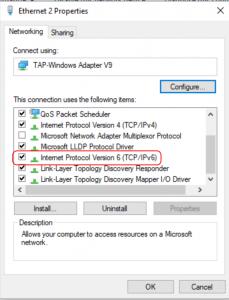For some time I have had some strange symptoms on Windows 10 systems when they were accessing the Internet over a VPN connection. In my case the VPN provider was TigerVPN. This issue is unrelated to the provider, but is instead caused by the Windows networking stack when used with the OpenVPN software (which many VPN providers use). More on that later, first let’s explore the symptoms.
In my case the problem manifested itself in many different ways, but it seems they all stem from the inability to sign in to Microsoft Accounts (MSA) when the VPN connection was active. For example the Microsoft Store app did not work and I was constantly informed that I needed the Internet to do what I wanted to do (hence the title of this article). This was the error the Store gave me;
You’ll need the internet for this.
It doesn’t look like you’re connected to the internet. Please check your connection and
try again.
Ox800704cf
The network location cannot be reached. For information about network
troubleshooting, see Windows Help.
Hitting the “Send Feedback” button would open the Feedback Hub app , which would be stuck at an endlessly looping “Let’s get you signed in” screen. Very helpful…
Other problems include, but are probably not limited to, not being able to change your Windows Insider settings and issues with the Xbox app. All other network operations that I tried worked fine, but there could also, of course, be other issues.
So why did this happen?
It turns out that OpenVPN supports IPv6 connections inside the tunnel by default since version 2.3.0. This is good, we all like IPv6, but not all VPN providers support it on their servers, which is also fine. But not forever, and not without telling you. Windows 10 (and all versions since Vista) also support IPv6 by default and has a dual IPv4/IPv6 stack that will try to use both protocols simultaneously. In addition, Windows also has a number of IPv6 transition technologies built in. This is also good. If everything supported IPv6 through the entire stack and connection these problems would not present themselves. But this time that was not the case. My VPN provider did not support IPv6 and had it turned off. (I am unsure of how, exactly, they disabled IPv6 but I see the message did_ifconfig_ipv6_setup=0 every time I connect and take that to mean that IPv6 has been disabled either as a setting pushed by the server or in the client config file (.ovpn). But Windows did not know that IPv6 was disabled in the OpenVPN software so the tunnel adapter that OpenVPN creates still had IPv6 enabled. So Windows thought that the connection supported IPv6, but it did not. This is usually not a problem. When I looked in network connections this is what I saw:
The TAP adapter (Ethernet 2) is the OpenVPN software tunnel adapter. As you can see the Connectivity status is listed as “No network access”, but network access was working fine except for the issues mentioned. The properties of the adapter looked like this:
Notice that the IPv6 protocol is enabled. When I disabled IPv6 on the adapter, and thus making the connection pure IPv4, the Connectivity status immediately changed to “Internet access”, and all problems were resolved. And there was much rejoicing…
I can’t say exactly what caused this issue to arise. After all, having IPv6 enabled on adapters that are connected to IPv4-only networks works fine. I suspect this has something to do with one of IPv6’s transition technologies, Teredo, 6to4, ISATAP or PortProxy, but I did not investigate this further. This is a case where I am happy to accept the empirical fact that turning off IPv6 resolves the problem.
I have not seen any negative effects of this “fix”. My VPN provider does not support IPv6 yet so I am not loosing anything by disabling it on my adapter. When TigerVPN finally implements IPv6 support I expect that I can leave IPv6 enabled and not experience any issues. Time will tell.
NOTE: While we are on the subject of VPNs and IPv6 I would be remiss if I did not mention what is known as “IPv6 leak”. Very quickly “IPv6 leak” can happen if your VPN provider only supports IPv4 and not IPv6, and worse, just ignores any IPv6 traffic. If your ISP supports IPv6 and you get an IPv6 public address over which you can route traffic; that traffic will not be captured by your VPN provider (since they ignore it), and could thus “leak” and expose your identity, location and activities. Some VPN providers support what they call “IPv6 leak protection” where they still do not support IPv6, but when the VPN connections is established they insert black hole routes to all IPv6 destinations. I strongly recommend you find out exactly how your VPN provider handles IPv6 if you rely on VPNs to maintain your privacy (as you should).
M
More information:
- IPv6 support in OpenVPN
- See if your connection supports IPv6
This is how you can see if you are a potential victim of IPv6 leak. - TigerVPN
I like it, and that is as close to product endorsement as I will ever get… - TigerVPN IPv6 Support
(This article is about a Mac OS issue, but it also states that IPv6 is not supported, which is what we are interested in here.) - IPv6 Transition Technologies


